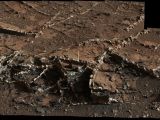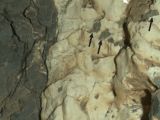Earlier this week, scientists at NASA released a stunningly detailed view of a network of light and dark mineral veins resting on Mars' Mount Sharp, in an area dubbed Garden City.
The view, available in the gallery below, combines as many as 28 images that the agency's Curiosity's rover obtained during a March 18 hike. The gallery also features a close-up of one of the veins.
How Mount Sharp's network of mineral veins formed
In a statement, NASA researchers explain that this network of veins, estimated to weigh about 2 tons, formed from minerals deposited over the centuries by fluids moving across the surface of Mars.
In time, the veins proved more resilient to erosion than the rock surrounding them did. Hence the fact that they now rise about 2.5 inches (roughly 6 centimeters) above the ground.
As for the veins' width, NASA scientists say the majority measure around 1.5 inches (approximately 4 centimeters) across. Since they comprise various minerals, they appear as both dark- and light-colored.
“Some of them look like ice-cream sandwiches: dark on both edges and white in the middle,” explains Linda Kah, Curiosity science-team member at the University of Tennessee in Knoxville.
The Garden City area that is host to this network of mineral veins sits about 39 feet (12 meters) higher than the bedrock that forms Mount Sharp's basal layer and that the Curiosity rover spent several months investigating.
The mineral veins hold clues about Mars' history
As mentioned, such veins form when fluids casually moving through cracked rocks deposit minerals in whatever fractures they come across. It often happens that the minerals alter the chemistry of the rocks they are deposited on.
Since these veins on Mouth Sharp comprise both light and dark minerals, it's safe to assume that they were created by at least two different fluids that flowed on Mars' surface at different times in the planet's history.
NASA researchers know for a fact that the network must have formed long after the wet environmental conditions that created lake-bed deposits close to Mount Sharp's base.
Thus, they say that, in order for the mineral veins to come into being, the Martian mountain must have first dried up and consequently fractured. The exact processes that created the network, however, remain a mystery.
“At least two secondary fluids have left evidence here. We want to understand the chemistry of the different fluids that were here and the sequence of events,” says scientist Linda Kah.

 14 DAY TRIAL //
14 DAY TRIAL // 

